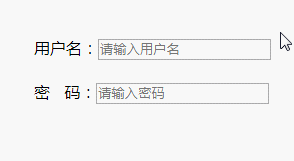Home >Web Front-end >CSS Tutorial >How to set the style of placeholder in css3
The content of this article is to introduce how to use css3 to set the style of placeholder, so that everyone can understand what placeholder is, how to use it, and how to modify (set) its style. It has certain reference value. Friends in need can refer to it. I hope it will be helpful to you.
First of all, let’s understand what placeholder is?
placeholder is a new attribute in HTML5. The function of this attribute is to specify a short prompt message that describes the expected value of the input field. This prompt will be displayed in the input box before the user inputs, and then Disappears after the user enters the field. [Related video tutorial recommendation: HTML5Tutorial]
Depending on the browser, when the input field (box) becomes the focus, the prompt message (placeholder) may remain visible. It may also not remain visible. For example, IE10 will hide when the input is focused, even if it is still empty.
Applicable scope:
The placeholder attribute is applicable to the following input types: text, search, url, tel, email and password.
Compatibility:
Because it is a new attribute in HTML5, there will be compatibility issues. Let's take a look at browser support:
The number in the table indicates the first browser version number that supports this attribute.
Basic usage of placeholder attribute, example:
用户名:<input type="text" placeholder="请输入用户名"> <br /> 密 码:<input type="password" placeholder="请输入密码">
Rendering:

Generally placeholder Attributes will have their own default styles. Sometimes we want to customize the style for the overall beauty of the page. So how to set the style of the placeholder?
Below we will use a simple code example to introduce how to use css3 to set the style of placeholder.
css3 setting placeholder style code example:
input::-webkit-input-placeholder {
color: palevioletred;
}
input::-moz-placeholder {
color: palevioletred;
}
input:-ms-input-placeholder {
color: palevioletred;
}
input::-webkit-input-placeholder {
color: palevioletred;
}
input::placeholder {
color: palevioletred;
}Rendering:

It can be seen that we use css3's ::placeholder pseudo-element is used to set the placeholder attribute style . In css3, the pseudo element::placeholder is used to set the style of the object text placeholder. [Related video tutorial recommendation: CSS3 tutorial]
Description:
::placeholder pseudo-element is used to control the placeholder of the form input box Appearance, which allows developers/designers to change the style of text placeholders. The default text placeholder is light gray. When the form background color is a similar color, the effect may not be very obvious, so you can use this pseudo element to change the color of the text placeholder.
Note:
Some browsers have their own non-standard implementation of the ::placeholder pseudo-element. All these implementations require browser prefixes. Examples of these implementations are ::-webkit-input-placeholder, :-ms-input-placeholder (single colon), and :-moz-placeholder. Deprecated in Firefox 19, the newer one supported is ::-moz-placeholder Pseudo element.
Except Firefox which uses ::[prefix]placeholder, other browsers use ::[prefix]input-placeholder.
Pseudo-element::placeholder compatibility:

::-moz-placeholder pseudo-element After Firefox 19, it replaced the previous:-moz-placeholder pseudo-class
Summary: The above is the entire content of this article, I hope it will be helpful to everyone's learning.
The above is the detailed content of How to set the style of placeholder in css3. For more information, please follow other related articles on the PHP Chinese website!